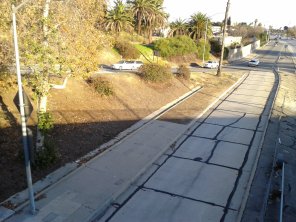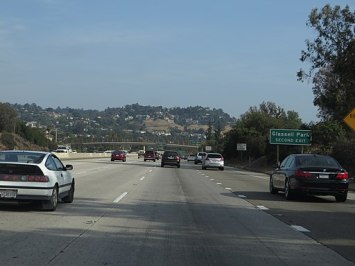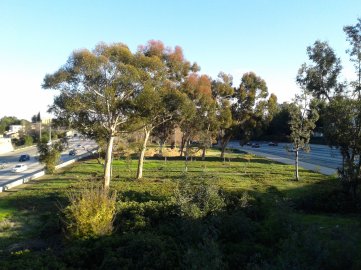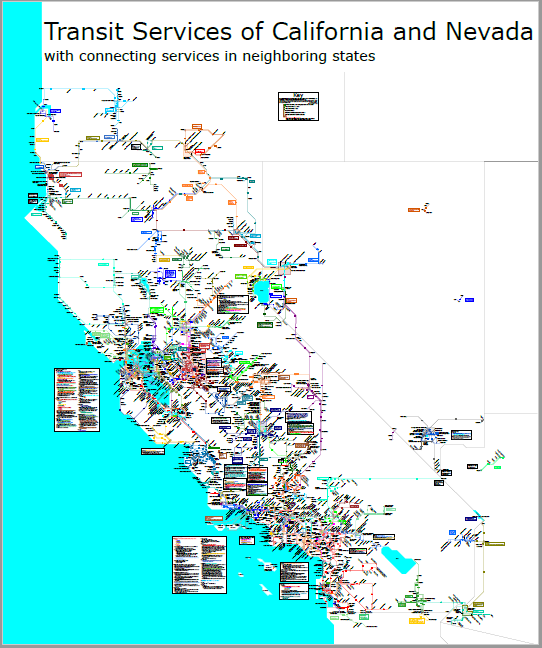
Bus pad at the Vermont Avenue exit of the northbound Hollywood Freeway
After writing about the idea of repurposing the 2 freeway as a tranistway, I’ve been thinking a lot again lately about buses and freeways, and specifically about bus pads: areas at a freeway interchange where there’s a lane for buses connecting the off-ramp to the opposite on-ramp. A bus stop is placed on this lane, along with, obviously, some means for pedestrians to access it from the surface street. The idea is to allow express buses to pick up and drop off passengers without getting slowed down by cross traffic the way they would if they exited the freeway outright. Now, bus pads have a lot of obvious drawbacks as a way of delivering rapid transit: buses running in mixed freeway traffic will be slowed down at rush hours; the area right around a freeway is likely to be comparatively lacking in nearby walkable destinations; the air quality won’t great for people waiting at the stop; and with certain interchange geometries, pedestrians may be forced into dangerous conflicts with traffic on ramps to reach the stop. Still, I’ve long been interested in the past and present of this particular form of transit infrastructure, which one might have imagined to be typical of a freeway-heavy place like Los Angeles.
As far as I know, there are seven active bus pads Los Angeles County:
- On the 110 at Carson Street and Pacific Coast Highway
- On the 101 at Alvarado Street, Vermont Avenue, and Western Avenue
- At Vermont, in addition to the bus pads on the sides of the freeway, there’s also a disused one in the median on the southbound side.
- On the 10 at Puente Avenue and Azusa Avenue
- As I understand, these are currently open only in the westbound direction due to construction for the 10 HOV lane project.
I wanted to ask here about three other places where I’ve noticed what look like former bus pads, but which as far as I can tell are no longer in use:
- On the 110 at 7th Street on the west side of Downtown Los Angeles. (Look for the stairs leading down from the street to the side of the freeway; in the Google Maps satellite image I’ve linked to, these are most visible on the north side of the street, going down to the southbound freeway lanes. This one is also a bit different because it’s just at an underpass, not at an actual exit.)
- Two on the 10 at West Covina Parkway and Vincent Avenue. (If you look at the satellite images, you can see remains of sidewalks and crosswalks leading up to the slip ramp, and distinct pavement at what I take to be the place where the bus would have stopped.)
Does anyone have information about if or when these were most recently in use by buses? For the latter two, does anybody know if they’ll still exist after the I-10 HOV project is completed? Any information would be more than welcome via email at transiting dot la at gmail dot com. Thanks!
Footnote: Bus pads as defined above might be regarded as the middle of three taxonomic grades of freeway-based bus stops. The highest level are stops located along dedicated bus-only lanes or HOV/HOT lanes. In LA, the Rosecrans, Harbor Freeway/I-105, Manchester, Slauson, and 37th Street/USC stations on the Harbor Transitway, and the Union Station, LAC+USC Medical Center, and Cal State LA stops on the El Monte Busway fall into this category. Harbor Gateway Transit Center and El Monte might be described as terminal stations located at the end of such lanes.
At the next level down are bus pads. With these, buses have to operate in mixed traffic on the freeway, but their route is still fully grade-separated; they don’t have to leave the freeway to stop for passengers.
Below these are a category for which I’m not aware of there being an established term: the bus exits the freeway, crosses the intersecting surface street, and then re-enters the freeway at a directly-opposite entrance ramp, stopping for passengers near the end of the exit ramp or the start of the entrance ramp. In LA County, I know of examples of these on the 101 at Van Nuys Boulevard and Reseda Boulevard (northbound only); on La Cienega Boulevard at Slauson Avenue; and on the 10 at the Fairplex park-and-ride (westbound only). I think there at least used to be one on the 10 at Via Verde.
If anybody knows of further examples (past, present, or proposed) of any of these categories, I’d be happy to hear about those too!


